
The Klondike Gold Rush was a migration by an estimated 100,000 prospectors to the Klondike region of the Yukon, in north-western Canada, between 1896 and 1899. Gold was discovered there by local miners on August 16, 1896, and, when news reached Seattle and San Francisco the following year, it triggered a stampede of prospectors. Some became wealthy, but the majority went in vain. It has been immortalized in artifacts, films, games, literature, and photographs.

Dawson City, officially the Town of the City of Dawson, is a town in the Canadian territory of Yukon. It is inseparably linked to the Klondike Gold Rush (1896–99). Its population was 1,375 as of the 2016 census, making it the second largest town of Yukon.
"The Cremation of Sam McGee" is among the most famous of Robert W. Service's (1874–1958) poems. It was published in 1907 in Songs of a Sourdough. It concerns the cremation of a prospector who freezes to death near Lake Laberge, Yukon, Canada, as told by the man who cremates him.

Bennett Lake is a lake in the Province of British Columbia and Yukon Territory in northwestern Canada. It is just north of the border with the United States state of Alaska, near the Alaskan port of Skagway.

Klondike Gold Rush National Historical Park is a national historical park operated by the National Park Service that seeks to commemorate the Klondike Gold Rush of the late 1890s. Though the gold fields that were the ultimate goal of the stampeders lay in the Yukon Territory, the park comprises staging areas for the trek there and the routes leading in its direction. There are four units, including three in Municipality of Skagway Borough, Alaska and a fourth in the Pioneer Square National Historic District in Seattle, Washington.

Lake Laberge is a widening of the Yukon River north of Whitehorse, Yukon in Canada. It is fifty kilometres long and ranges from two to five kilometres wide. Its water is always very cold, and its weather often harsh and suddenly variable.
Canyon City is a Klondike Gold Rush ghost town and a Yukon Government Heritage Site. It is located about 7 km from downtown Whitehorse, Yukon at the upstream end of Miles Canyon on the Yukon River. Summer tours are encouraged.
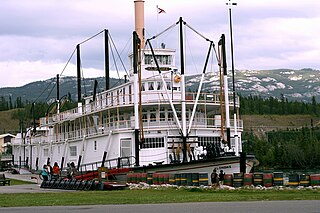
SS Klondike was the name of two sternwheelers, the second now a national historic site located in Whitehorse, Yukon, Canada. They ran freight between Whitehorse and Dawson City along the Yukon River, the first from 1929-1936 and the second, an almost exact replica of the first, from 1937–1950.
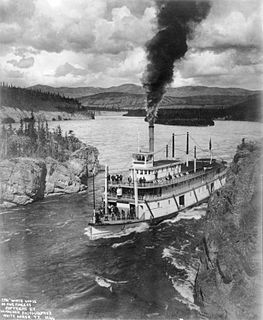
Steamboats on the Yukon River played a role in the development of Alaska and Yukon. Access to the interior of Alaska and Yukon was hindered by large mountains and distance, but the wide Yukon River provided a feasible route. The first steamers on the lower Yukon River were work boats for the Collins Overland Telegraph in 1866 or 1867, with a small steamer called Wilder. The mouth of the Yukon River is far to the west at St. Michael and a journey from Seattle or San Francisco covered some 4,000 miles (6,400 km).

Gwendoline was a sternwheel steamer that operated on the Kootenay River in British Columbia and northwestern Montana from 1893 to 1899. The vessel was also operated briefly on the Columbia River in the Columbia Valley.
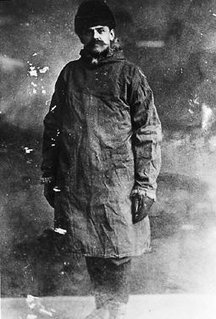
Francis Patrick Armstrong was a steamboat captain in the East Kootenay region of British Columbia. He also operated steamboats on the Kootenay River in Montana and on the Stikine River in western British Columbia. Steam navigation in the Rocky Mountain Trench which runs through the East Kootenay region was closely linked to Armstrong's personality and career. In addition to being a steamboat captain, Armstrong was also a prospector, white-water boat pilot and guide in the Big Bend country of the Columbia River.

The river sternwheeler Ramona operated from 1892 to 1908 on the Willamette River in Oregon, on the Stikine River running from Wrangell, Alaska into British Columbia, and the Fraser River, in British Columbia. This vessel should not be confused with the coastal steamship Ramona which also ran in Alaskan waters.
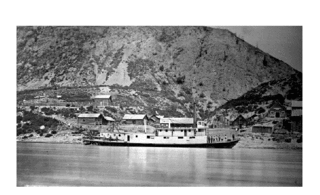
Steamboats operated on the Stikine River in response to gold finds in along that river and in the Cassiar Country of northwestern British Columbia, Canada.

Monte Cristo was a sternwheel steamboat which was operated in Puget Sound and the coastal rivers of the state of Washington and the province of British Columbia.

In what was characterized as the worst disaster in the Yukon River's history, the sternwheeler Columbian exploded and burned at Eagle Rock, Yukon, Canada, on 25 September, 1906, killing six men. The steamer was carrying a crew of twenty-five men and a full cargo, including cattle and three tons (2.722 t) of blasting powder destined for the Tantalus coal mine, thirty miles (48 km) downriver.
D.R. Campbell was a sternwheel steamboat built in Seattle in 1898 which ran on the Yukon and tributary rivers in Alaska.

The Moran sternwheelers were a set of 12 almost identical sternwheel steamboats built in 1898 by the Moran shipyard in Seattle, Washington to run on the Yukon and tributary rivers in Alaska.

The SS Keno is a preserved historic sternwheel paddle steamer and National Historic Site of Canada. The SS Keno is berthed in a dry dock on the waterfront of the Yukon River in Dawson City, Yukon, Canada.
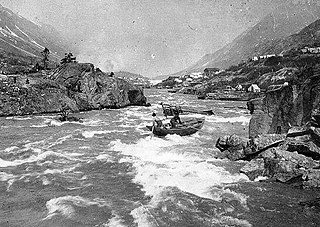
Lindeman Creek, formerly known as One Mile River connects Bennett Lake to Lindeman Lake, areas on the Chilkoot Trail in far northwestern British Columbia, Canada. It flows just south of Bennett Lake and northeast of the summit of the Chilkoot Pass. It is a treacherous class 3 rapid river.
















